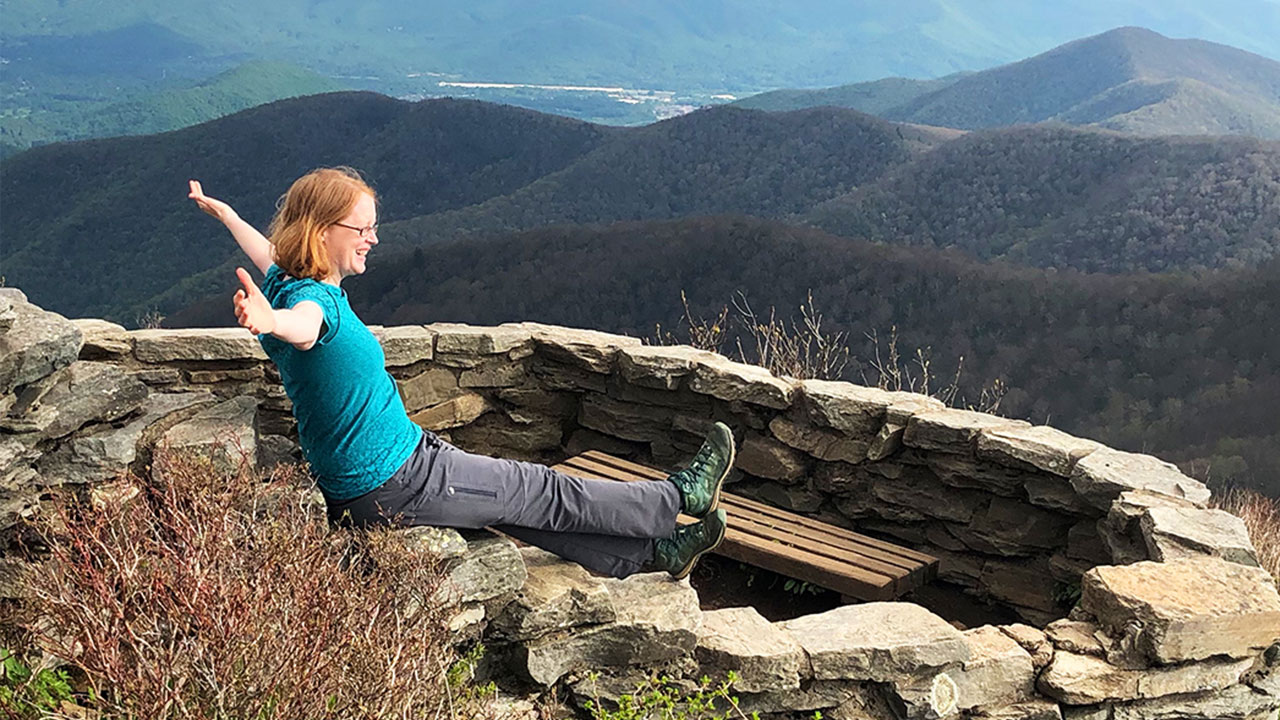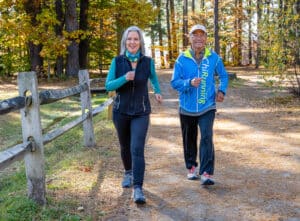By Berni Kozlowski, RYT-200, Certified Meditation Coach
You probably know how to align your posture and engage your core so you can run injury-free. And you probably understand the mind-body connection of a sustainable running practice, but what you might not know is how you can use a simple and easy 10 minute meditation to enhance that connection.
When you run with relaxed muscles, you move with grace, ease, and awareness.
I’m a meditation coach and former runner, and when I was training for triathlons, I dealt with aches and pains because I was tensing up my whole body and pushing it past its limits. From then on, I became wiser about training more relaxed and finding more joy in the whole process.
When you are constantly battling a racing mind, pushing harder but not going faster, you can feel like you’re not getting anywhere. If you are in your head so much that you aren’t even aware of your surroundings, your body will feel anxious.
And when the frustrations pile up, it can feel like you’re putting way more into your workout than you’re getting out of it.
When we’re feeling stressed or worried, that worry can lead directly to muscle tension, which dramatically increases your chances of injury while running. Stress Reduction Made Easy shows how belly breathing and doing more fun runs can help relax those muscles and calm your mind.
But it’s a balance.
If you are too relaxed, you may as well be taking a nap. But if you are focusing too hard, your body will tense up and you’ll increase your chances of injury.
The key is to be more relaxed in your mind, your breathing, and your surroundings.
Move through your run and your world with relaxed alertness using discernment about what really needs effort, breathing more easily, and having great situational awareness. You’ll be faster and more flexible and your times will drop.
You hear that the highest performing runners train more, train harder, or have just the right body type. You, on the other hand, have to suffer through plateaus, boredom, and injury for a few more years before you can get the results you want.
That’s not quite true.
In fact, there are several key principles to getting the most out of your runs without suffering through boredom or unnecessary strain:
#1: Knowing how to deal with racing thoughts affects your body physically and helps you have greater discernment about what really needs your energy.
#2: There are other ways to breathe besides breathing deeply. You don’t need a breathing technique that works for others, you need one that works for you. It’s easier to breathe when you have more techniques in your toolkit.
#3: By opening your senses, you are re-wiring your brain to be more aware. You’ll move more gracefully with more enjoyment when you practice open awareness with your senses as much as you practice your running form.
When you combine these attitudes, you’ll not only be a more efficient runner but you’ll build the reputation of being a graceful runner.
If you get out of your head and move with relaxed alertness, your muscles will loosen, making you flexible and faster and more pleasantly present to the overall experience.
This state of relaxed alertness involves three parts: your mind, your breathing, and your awareness using your senses.
So, how do you actually do that? Well…it’s simpler than you might think. Keep on reading, and then give it a try with this free audio meditation download.
3 Steps to Running with Relaxed Alertness
Step 1: Relax Your Mind
First, give yourself permission to rest.
Say these words, and feel them in your belly:
“I give myself permission to rest.”
Did you feel really restful? Or did you feel like there were racing thoughts? Or a feeling of agitation?
It’s fine if you didn’t feel restful when you said it. Try doing it every day, and eventually you’ll become successful every time you do it.
It’s a myth that you need to stop your thoughts in order to rest.
Rest doesn’t mean an absence of thoughts––it means that you don’t have to fix or solve anything right now. There’s a myth in meditation that your mind has to be blank to be relaxed. Instead, when thoughts arise, try giving them some gentle attention and then letting them pass on by. This is different from trying to suppress or block or stop thoughts.
If you feel any agitation or struggle, add a few words to your statement like this:
“I give myself permission to rest. I welcome thoughts, I just don’t have to fix or solve or change anyone or anything right now.”
People find that when they say these words with some meaning, their breathing slows or their bodies soften a little bit.
You can practice this while seated, walking, running, biking, or swimming! Experiment and pay attention to how it feels in your body.
When I was doing triathlons, I learned how to do drill work in the pool and reduced my times. Once I plateaued, I tried getting faster by pushing, by tensing my muscles more and I got slower!
Then, I remembered my meditation training and said “I give myself permission to rest.” Those laps felt so effortless I was convinced I was going slower until I checked my watch and my time had dropped!
Permission to rest is not about blocking or stopping or ignoring thoughts or emotions. Rest is welcoming them, letting them arise and receive some attention and go on their merry way without actively engaging.
Welcome thoughts like welcoming a good friend. You can listen and give them attention, but you don’t have to solve their problems. Friends just want to be heard.
Step 2. Relax In Your Breathing
There’s more to breathing than just taking a deep breath. There are many subtleties of breathing that will tell your body to switch into the parasympathetic response. Here are several ways to make your breathing slower and softer and ultimately more efficient:
- Nose breathing is better than mouth breathing. Most people are mouth breathers, which causes greater dehydration and you actually extract up to 20% less oxygen with each breath.
- Notice the transition between your inhale and your exhale. Is it smooth or is there a delay or pause? Explore making that transition as smooth as possible.
- A longer exhale, a deep sigh, triggers the relaxation response. Notice the length of the inhale vs the exhale. If your inhale is longer than your exhale, you are likely stress breathing.
Try This:
Inhale and tense your body for a second or two. Then exhale and try to tense your body again to about the same intensity. It’s harder to tense your muscles when you are exhaling.
A longer exhale keeps your muscles more relaxed. As a softball coach, I learned that exhaling as you are about to field a ground ball keeps you more fluid and keeps your reactions fast.
When golfing, I used to inhale on the backswing and then hold my breath on the downswing. My arms would tense and the shot would be erratic. I found that if I exhaled through the entire swing, I could hit the ball farther, with more accuracy and less effort.
- Belly breathing. Breathe normally and notice if you tend to breathe in the belly or higher up in the chest which stimulates the stress response. Breathing in your belly triggers relaxation response receptors. Being as gentle as possible, explore the gentle movement of your lower ribs lifting up and out. Feel or imagine your diaphragm lowering or your belly inflating.
- Breathe less or breathe slower. When you breathe slower the air stays in your lungs longer, allowing you to extract more oxygen with each breath. Slower breathing tells your nervous system things are ok!
- Explore passive breathing, where you let go of controlling your breathing and allow your body to do it subconsciously. You breathe involuntarily when you’re asleep or unconscious. Go ahead and breathe like that, appreciating the magic that your body will fill with air and expel air all by itself with no input from you. Enjoy the quality of breathing softly and easily.
Step 3. Relaxed Awareness
Before I had meditative tools, I used to go for long hikes in the woods or for runs when I was doing triathlons, and I would use that time to think hard through some issue or problem in my life. I was stuck in problem-solving mode, and I might come out with a to-do list, but never deep Aha Moments or insights or a sense of rejuvenation.
When I was lost in my head, I would often be startled by a noise in the woods or a runner approaching me on the trail. I would get startled and my heart rate would jump up and I’d feel rattled. When I move through the woods with greater awareness, I can hear or see the tiniest of movements and be ready for the unexpected.
When we are startled, we are unable to think clearly for up to 10 seconds. This is deadly for pilots or drivers of cars or for clear functioning during our days. Moving with greater ease puts us more in the flow. Not only are we faster and more flexible physically, but mentally and emotionally as well.
Try This:
I am aware of seeing.
Let go of control and let your eyes move wherever they want to go. You might notice colors or textures or shapes. Maybe you are drawn to the movement of leaves on the trees or the sight of a bird in flight. Maybe you are intrigued by the play of light and shadow on the path ahead.
I am aware of hearing.
Be willing to be surprised by what you hear. Maybe your attention is caught by birdsong, or the sound of water in a stream, or by wind rustling in the trees. Maybe you hear musical or repetitive sounds.
I am aware of the smell.
Just saying this statement will cause you to take in a fuller breath. Maybe you smell rain in the air, someone barbecuing, the smell of a lilac tree in the neighbor’s yard, or the smell of wood fire from someone’s chimney. Take delight in what you smell and welcome any memories that may arise from these smells.
I am aware of touch.
“Of the touch of sun on my face. The breeze against my skin. The weight of my running clothes on my body. The touch of my feet against the earth.”
I am aware of the space beneath my feet and the space above my head.
Sometimes just opening one or two of your senses in this way is enough to get you out of your head and into the moment.
Then when I learned to move with more awareness, I was suddenly present to being in nature, and I came out with deeper ahas or insights or mental clarity and definitely more rested.
My swimming also improved when I would focus on a different sense every lap. I was amazed by the sight of bubbles formed as my hands moved through the water. Intrigued by the sounds of my breathing or the splashing of other swimmers. The silky touch of the water on my skin.
I went from being totally bored to having a child-like curiosity about being in the water.
Ready to try it? Click here to download the audio walkthrough of this meditation.
It follows this flow:
- Relax in Your Mind
- I Give Myself Permission to Rest. I don’t have to solve or fix or change anything right now.
- Relax in Your Breathing
- Nose breathing/passive
- Smooth transition
- Longer exhale
- Slower/longer breaths
- Belly breathing
- Relax in Your Surroundings: Developing Situational Awareness
- I am aware of seeing
- I am aware of hearing.
- I am aware of smell.
- I am aware of touch.
- I am aware of the space beneath my feet and above my head
Do this as a warm-up. You can do each part for 30 seconds to a minute. Or, instead of timing it, do each exercise for a lap or to the next stop sign or the next turn in the path. So use this 10 minute warm-up exercise to practice being relaxed in your mind, your breathing, and in your surroundings.
Shake it up a little bit
One day go for a run and breathe entirely through your nose and see how you feel. Another day do the same run but breath entirely through you mouth and notice how you feel
Try this meditation while seated, while doing a Calming Walk, or going for a Fun Run. No more being bored on your runs. No more slaving away to shave off a few more seconds off your 5K.
How?
Running with relaxed alertness puts you in a position of getting more out of your run by easing your breathing and taking in the details. You finally get to move through the world in a calmer fashion, not just once, but for the rest of your life, both as a runner and in your day to day life.
If you want to run with relaxed alertness, warm up with relaxed alertness using this free audio guide.
Berni Kozlowski isn’t your typical meditation coach. Based in Asheville, Berni-K’s Rest Revolution helps people ditch the overwhelm and profoundly shift their lives, to bring more joy and wonder into their days. Connect with Berni at www.berni-k.com





